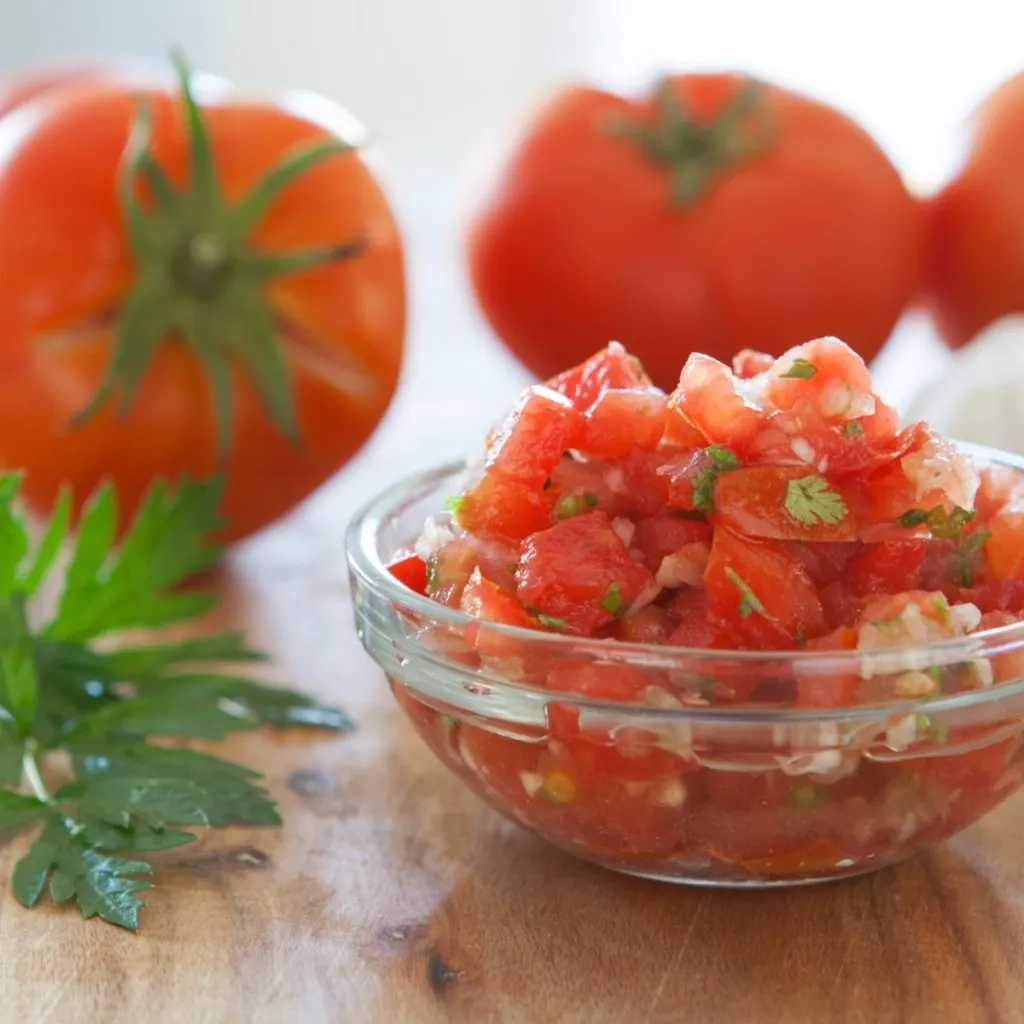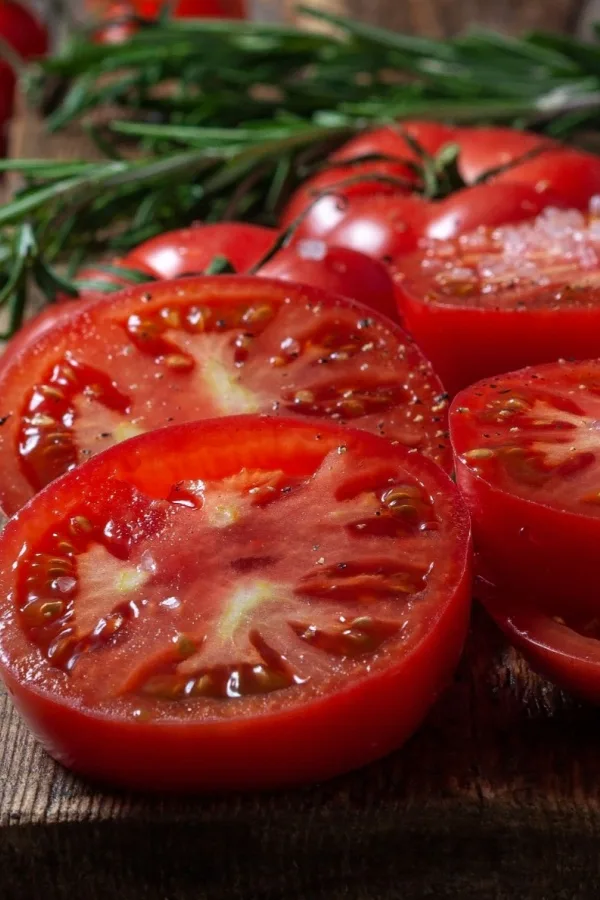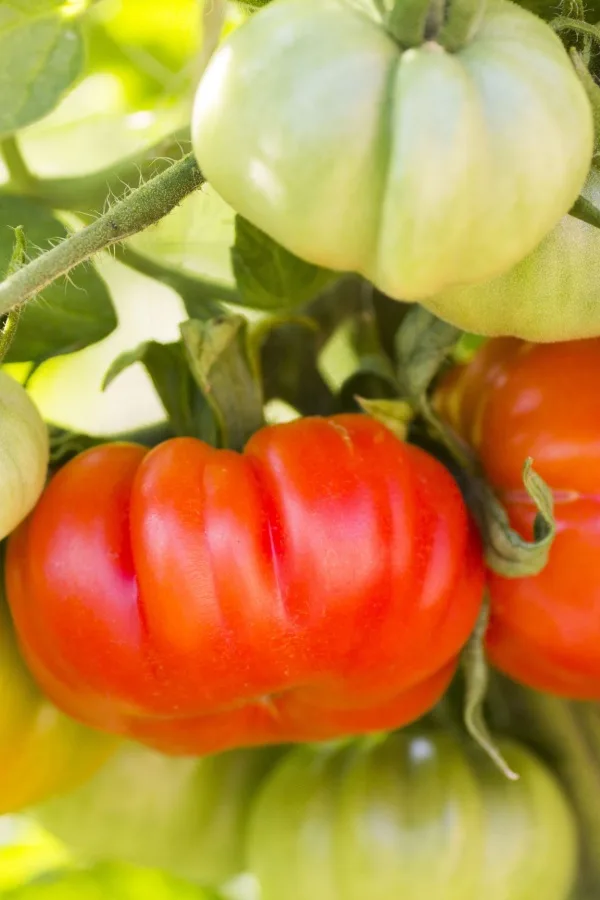When it comes to making the best salsa around, it all starts with growing and using the right kinds of tomatoes – and it’s hard to beat the 5 homegrown varieties featured today!
If you’ve never had a taste of fresh, homemade salsa, then you are truly missing out! Those store-bought commercial salsas just can’t quite compare to using the bright flavors of freshly picked, homegrown ingredients.
And it’s no secret that the main star of an amazing bowl of salsa are the tomatoes. While peppers, onions, and spices are definitely required additions, it’s the tomatoes that really take the show – but using the right varieties of tomatoes makes all the difference!

Not all tomatoes are created equally and work well for creating salsa. While they all feature bold colors in a variety of sizes, they also have different flavor profiles and textures that might not fit the bill when it comes to turning into a thick and flavorful salsa.
With over 10,000 tomato varieties available, it can be a bit overwhelming to know which is the best type and variety to use. Thankfully, this article puts together the ideal textures and flavors by pairing 5 of the best tomato varieties that will result in an amazing, flavor-packed salsa!
What Type Of Tomatoes To Use – 5 Best Tomatoes To Grow For Salsa
Don’t just settle on using one variety of tomatoes in your salsa recipe. If you do, you’ll likely end up with a dish that is flat and lacking in both flavor as well as texture.
The best types of salsa are instead made with multiple different tomato flavors and textures. The variety of pairings that you use is what will bring the dish to life!
Use a mixture of both sweet and acidic tomato varieties as well as those with different liquid contents. You will have the best results by using a mix of both slicing tomatoes and roma tomatoes.
Slicing Tomatoes Vs Paste Tomatoes
Slicing tomatoes are typically full of juice and seeds. This typically results in a more flavorful, sweeter tomato. While they might be packed full of flavor, they aren’t the best choice for the bulk of your salsa recipe.

Limit slicing tomatoes to make up only around 25% of your recipe. A salsa made solely of slicing tomatoes will leave you with a runny salsa that has no body and can’t stand up to a chip.
For the bulk of your salsa recipe, use paste tomatoes. These types of tomatoes are thick and meaty with very few seeds and liquid. In turn, they help to create a thicker consistency of salsa.
Paste tomatoes typically have higher acid levels, which helps to balance the sweetness of the slicing tomatoes in your recipe. In addition, paste tomatoes are able to handle being cooked down and processed in case your recipe calls for that. (For a great canned salsa recipe, see “Easy Mild Salsa Recipe”.)
Using a combination of the 5 below slicing and paste tomato varieties will provide you with the best fresh salsa flavor as well as the ideal texture.
The 5 Best Salsa Tomatoes To Grow
San Marzano
Hands down one of the best tomatoes for making salsa, the San Marzano is worlds above the rest – and for good reason! Due to its high popularity, you can easily find both San Marzano seeds as well as transplants during planting time. Seed Link: Gardeners Basics San Marzano Tomato Seeds

This meaty tomato features a rich and intense, slightly sweet flavoring. It has plenty of acid which helps to make it safe for water bath canning. And speaking of canning, its thick texture holds up well to being cooked down and processed in canned salsa recipes.
The San Marzano plant is an heirloom variety. It consistently pushes out loads of 4 to 5-inch long fruit that are about 2 inches wide. As an indeterminate plant, it will continue to produce tomatoes up until the first frost.
Roma – 5 Best Tomatoes To Grow For Salsa
Another great paste tomato variety to try when making salsa is Roma tomatoes. The fruit measures around 3 to 4 inches long and has a plump, bright red plum-like shape. Seed Link: Roma VF Tomato Seeds
The Roma tomato has firm flesh with thick walls and few seeds. This makes it excellent for adding body to salsa recipes, even those that need cooked down. The flavor is mild yet still has plenty of acid for safe canning.
The determinate plants grow nice and compact, making them a great choice for growing in containers or raised beds. But don’t let their smaller size fool you. They will still push up plenty of tomatoes within a few weeks, making them great for bulk harvesting and using in large batches of salsa.
Beefsteak
The heirloom Beefsteak tomato is likely one you instantly picture when you think of large slicing tomatoes. It is an old heirloom that consistently pushes out vigorous vines and plenty of 4 to 5-inch round tomatoes.

Beefsteak tomatoes feature a bit more juice than paste tomatoes. However, their sweet, delicious flavor makes them a great addition for adding to fresh salsa recipes. And with fruit that weighs around 1 pound each, a few tomatoes go a long way!
These slicing tomato plants are indeterminate and will continue to produce fruit long into the growing season. Using trellises or cages is a must with Beefsteak tomatoes due to their long vines and massive fruit that will eventually weigh down stems as they ripen. Seed Link: Sow Right Seeds Beefsteak Tomato Seeds
Oxheart – 5 Best Tomatoes To Grow For Salsa
Dating back to the early 1800s, the Oxheart tomato has been a favorite for generations for its deep flavor and meaty interior. They have few seeds and are perfect for adding a rich thickness to salsa and other canned products.
The Oxheart tomatoes get their namesake from their unique triangular shape that resembles the heart shape of a large animal (such as an ox). The hefty deep pink tomatoes typically weigh in between 1 to 2 pounds each.
These indeterminate plants grow to be large sizes, pushing out high yields of fruit long into the growing season. Ensure that they have the proper support and trellising to support the hefty fruit. Seed Link: Sow Right Seeds Oxheart Pink Tomato Seed
Amish Paste – 5 Best Tomatoes To Grow For Salsa
Another paste-style tomato, Amish Paste features a meaty texture that helps to add density and thickness to salsa recipes. The indeterminate plants continually yield 8 to 12-ounce-sized fruit up until the first frost.

The acorn-shaped tomatoes have dense walls and are almost seedless, so they work well in recipes that require processing. In addition, the intense flavor of Amish Paste tomatoes makes them excellent for adding variety to the other tomatoes on this list.
The plants themselves don’t grow to be as large as other vining varieties, so they work well for growing in containers or in raised beds. But their size doesn’t stop them from producing high yields of paste tomatoes. Seed Link: Amish Paste Heirloom Tomato
By combining these five delicious, meaty tomatoes together, you will produce a flavor-packed fresh salsa no matter what recipe you use! If you are looking for information on how to safely can your homemade tomato recipes, be sure to check out: How To Safely Can Tomatoes – What You Need To Know!
I Grow Tomatoes
Follow Our Facebook Page For Even More Great Tomato Growing Tips! I Grow Tomatoes Facebook Page
I Grow Tomatoes is a website created for those who love all things about tomatoes – from planting and growing – to cooking and canning! We publish two articles every week, 52 weeks a year. Sign up today to follow via email! This article may contain affiliate links.
